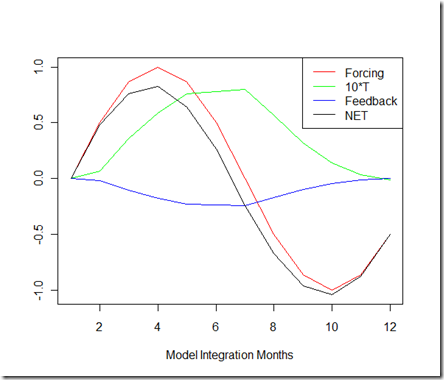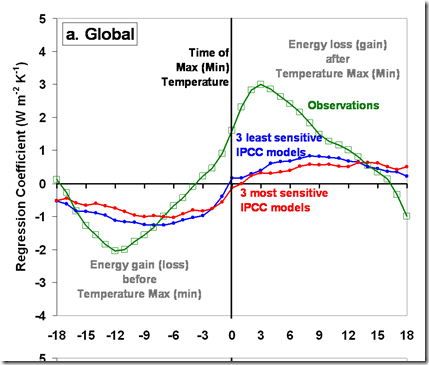As I noted in a previous blog post, and as mentioned at Climate Audit, the positive cloud feedback results (and excluding large negative feedbacks) of Dessler 2010 (not to be confused with Dessler 2011, which was the topic of my latest post) largely depend on using ECMWF ERA-Interim reanalysis for the clear-sky fluxes rather than CERES. The Cloud Radiative Forcing is determined by the difference between all-sky and clear-sky fluxes, and rather than using the CERES data for both clear-sky and all-sky, Dessler10 combines CERES all-sky with ERA clear-sky. The reason given for doing this is a suggested bias in the CERES clear-sky, with a reference to the Sohn And Bennartz 2008 paper.
In that first post, and in my guest post at Lucia’s, I pointed out two things:
1) The largest amount of this difference seems to come from the shortwave fluxes, which are unaffected by this longwave water vapor bias, and
2) Even if the OLR dry-sky bias was present, it would not account for the differences we see here:
But I’m doubtful that the LW result should be discounted based on measurement bias anyhow. For one, the SB08 paper refers to bias in the absolute calculation of CRF, not necessarily to the change in CRF, and the effect is minimal there (around 10% of only the OLR). Second, the bias should affect it in the opposite direction – it would make the cloud feedback appear more positive, not negative. From the SB08 paper, they mention: “As expected, OLR fluxes determined from clear-sky WVP are always higher than those from the OLR with all-sky OLR (except for the cold oceanic regions) because of drier conditions over most of the analysis domain.” Obviously, clear-sky days don’t prevent as much OLR from leaving the planet as cloudy days, and SB08 estimates that about 10% of this effect is from water vapor instead of all of it being from clouds. So, warmer temperatures should increase water vapor, which will be more prevalent on the cloudy days vs. the clear sky days, which in turn will make it appear that clouds are responsible for trapping more OLR than they actually do. In other words, the bias includes some of the positive feedback due to water vapor – which is already counted elsewhere – in the estimation of cloud feedback.
Now, Nick raised a point over at CA, that perhaps all we’re getting with ERA-Interim clear-sky fluxes is the CERES fluxes, but with this dry-sky bias removed:
What the reanalysis can then do is make the moisture correction so the humidity is representative of the whole atmosphere, not just the clear bits. I don’t know for sure that they do this, but I would expect so, since Dessler says that are using water vapor distributions. Then the reanalysis has a great advantage.
While I don’t believe this could be reconciled with either of the two points above (there is no dry-sky bias to "correct" in the shortwave fluxes, and the correction should be in the opposite direction), I want to give this a fuller treatment that should prove that the positive cloud-feedback result in Dessler10 is largely an artifact of combining the two different datasets.
If our hypothesis is that ERA_CRF is simply CERES_CRF corrected for dry-sky bias, we would be able to detect it rather easily be checking the relationship between the measured water vapor (total precipitable water from CERES) and the CERES_CRF-ERA_CRF differences. The following scatter plot shows that relationship:
As you can see, the "dry-sky bias correction", if it exists in ERA, accounts for very little of the difference we see between ERA_CRF and CERES_CRF. Please note the following point I made on that CA thread:
Since we’re calculating CRF as the difference between clear-sky and all-sky fluxes, ANY difference in those two datasets is going to show up in the estimated cloud forcing, including their different estimates of solar insolation (which has nothing to do with clouds). The magnitude of the changes in flux is far smaller that the magnitude of the total flux, so you would expect using two different datasets to have a lot more noise unrelated to the CRF. Note that if there is ANY flux calculation bias in either of the two datasets unrelated to clear-sky vs. all-sky, it WILL show up in the CRF, whereas if you use the same dataset, even if a flux calculation bias is present, it will NOT show up in CRF unless it is related to clear-sky vs. all-sky.
I’d like to pause a moment and note that the Dessler10 references to the ability of models to calculate clear-sky flux only refer to that of longwave flux. This is because the shortwave flux is rather trivial, assuming you know the incident solar radiation and albedo:
outgoing_sw_clr = incoming_sw * albedo_clr
Of course, there is no definitive monthly value for albedo and incoming solar radiation, as evidenced by the fact that CERES and ERA have different values for these. Albedo_clr is primarily just surface_albedo, although there is perhaps some aerosol mixed in. This next chart shows the effective clear-sky albedo, which can be calculated from outgoing_sw_clr/incoming_sw, but it could just as easily be put in terms of the differences in clear-sky short-wave fluxes:
Well, there you have it. The bulk of these CERES_CRF vs. ERA_CRF differences come from this different value for the effective surface albedo. Note that this has nothing to do with a "dry-sky" longwave water vapor bias. The value of 275? That is approximately incoming_sw * (1 – cloud_albedo), as we’d expect when calculating the flux difference between net and clear-sky with no cloud albedo change. I repeat, when combing the CERES all-sky flux with the ERA clear-sky flux, your “CRF” change will about equal to 275 * (CERES_surface_albedo-ERA_surface_albedo), even when no cloud properties have changed. This is what I mean by slight differences from either set showing up as a bias in the CRF estimate when you combine them.
Does it matter whether CERES surface albedo or ERA surface albedo is more correct? Not at all, as long as they’re consistent. You can make the corrections to the CERES short-wave all-sky flux to use the ERA surface albedo, or you can make the corrections to the ERA short-wave flux to use the CERES surface albedo, or you can just use CERES fluxes for both all-sky and clear-sky. But the important thing to note here is that by combining the CERES all-sky with ERA clear-sky, you get a difference in what is effectively surface albedo bundled in with the CRF term, despite having nothing to do with clouds.
Using HadCRUT with the CERES_CRF, I get a value of -0.50 W/m^2/K for the cloud feedback. Using HadCRUT with the ERA_CRF included in Steve’s file from Dessler, I get a value of 0.26 W/m^2/K (This is slightly lower than the Dessler10 paper because additional adjustments are made to go from CRF to R_cloud from radiative kernels, which I’m not disputing here). Correcting for the different effective surface albedos in the ERA_CRF, I once again get a negative value of -0.34 W/m^2/K. None of them have much in the way of correlations.
I have previously suggested why we likely see lower correlations here, and how to correct it, and so I consider -0.34 W/m^2/K to be an underestimate of the short-term cloud feedback. Nonetheless, to me there seems to be little ambiguity that the magnitude of the positive feedback in Dessler10 is more of an artifact of combining two flux calculations that aren’t on the same page, rather than some bias correction in ERA-interim. I would welcome any comments to the contrary.
The script I used for this post, along with some intermediate ERA data and the original CERES data, is available here. To get the ERA-Interim raw data, you’ll need to use the synoptic means, grabbing the data at time steps of 12 hours, with times chosen of 0:00 and 12:00, for the months 2000 through 2010, and selected variables of at least incidental solar radiation and the top net solar radiation for clear-sky.














